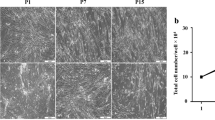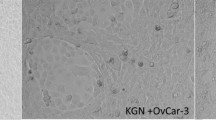Abstract
Reproducible culture conditions for obtaining large numbers of functional PCOS theca interna and granulosalutein cells will be indispensable in studies focussing on the molecular basis for androgen overproduction by ovarian cells of patients with polycystic ovarian syndrome (PCOS). The objective of the present study was to determine if granuiosa and theca interna cells obtained from ovarian follicles of patients with PCOS could be passaged with maintenance of inducible steroidogenic activity. PCOS theca interna and granuiosa cells were obtained from individual follicles of polycystic ovaries containing multiple cystic follicles with characteristic hypertrophied theca interna. Utilizing conditions for growing normal ovarian cells, both cell types were passaged successively and conditions for cell freezing, storing and thawing were established. In granulosa-lutein cultures grown and passed for successive passages, and transferred into serum-free medium, forskolin stimulated aromatase activity increased 3–10-fold over control non-stimulated values. Concurrent treatment with IGF-I (50 ng/mL) enhanced forskolin-stimulated aromatase activity in PCOS granulosa-lutein cultures. In passaged PCOS theca interna cells, forskolinstimulated 17α-hydroxyprogesterone production was increased 4–25-fold over control values. Treatment of PCOS theca interna cells with insulin (50 ng/mL) enhanced forskolin-stimulated 17α-hydroxyprogesterone biosynthesis. The effects of various growth factors and phorbol esters on 17α-hydroxylase activity in cultured PCOS theca interna cells was also investigated. Treatment of PCOS theca cells with EGF, FGF, TGFβ and TPA resulted in the inhibition of forskolin-stimulated 17α-hydroxyprogesterone production. These data suggest that PCOS theca interna and granuiosa cells respond to insulin and to the growth factors similarly to cells obtained from normal cycling ovaries.
Similar content being viewed by others
References
Axelrod, L.R. & Goldzieher, J.W. (1961).Arch. Biochem. Biophys.,95, 547–551.
Barbieri R.L., Makris, A., Randall, R.W., Daniels, G., Kristner, R.W. & Ryan, K.J. (1986).J. Clin. Endocrinol. Metab.,62(5) 904–10.
Barbieri, R.L., Smith, S. & Ryan, K.J. (1988a).Fertility and Sterility,50, 197–212.
Barbieri, R.L. & Hornstein, M.D. (1988b).Endocrinology Metab. Clin. North Am.,17(4), 685–703.
Erickson, G.F., Hseuh, A.J.W., Quigley, M.E., Rebar, R.W. & Yen, S.S. (1979).J. Clin. Endocrinol. Metab.,49, 514–519.
Erickson, G.F., Magoffin, D.A., Dyer, C.A. & Hofeditz, C. (1985).Endoc. Reviews,6, 371–99.
Erickson, G.F., Magoffin, D.A. & Jones, K.L. (1989).Fert. Steril.,51, 173–176.
Erickson, G.F., Magoffin, D.A., Cragun, J.R. & Chang, R.J. (1990).J. Clin. Endocrinol. Metab.,70, 894–902.
Erickson, G.F., Magoffin, D.A., Garzo, V.G., Cheung, A.P. & Chang, R.J. (1992).Human Reproduction,7, 293–299.
Franks, S., Mason, H.D., Poison, D.W., Winston, R.M.L., Magara, R. & Reed, M.J., (1988).Human Reproduction,3, 531–534.
Franks, S. (1989).Clin. Endocrinol.,31, 87–120.
Franks, S. (1992). Morphology of the polycystic ovary.Current Issues in Endocrinology and Metabolism. Polycystic Ovarian Syndrome. Dunaif A., Givens JR, Haseltine, F.P. & Merriam, G.R. (eds). Blackwell Scientific Publications: Boston. pp 19–28.
Goldzieher, J.W. & Green, J.A. (1962).J. Clin. Endocrinol. Metab.,22, 325–38.
Goldzieher, J.W. (1981).Fertility & Sterility,35, 371–394.
Mahesh, V. & Greenblat, R.B. (1964).Recent. Prog. Horm. Res.,20, 341–394.
Mason, H.D., Margara, R., Winston, R.M.L., Beard, R.W., Reed, M.F. & Franks, S. (1991).Clin. Endocrinol.,33, 511–17.
McAllister, J.M., Kerin, J.F.P., Trant, J.M., Estabrook, R.E., Mason, J.I., Waterman M.R. & Simpson, E.R. (1989).Endocrinology,125(4), 1959–1966.
McAllister, J.M., Mason, J.I., Byrd, W., Trant, J.M., Waterman, M.R. & Simpson, E.R. (1990).J. Clin. Endocrinol. Metab.,71, 26–33.
McAllister, J.M. & E.R. Simpson. (1993). Human theca interna cells in culture.Methods in Reproductive Toxicology. A Volume of Methods in Toxicology, Volume 3B. Academic Press. San Diego. pp. 330–339.
McAllister, J.M., Byrd, W. & Simpson, E.R. (1994).J. Clin. Endocrinol. Metab.,79(1), 106–112.
Sheehan, D.C. & Hrapchak, B.B. (1980). Nuclear and Cytoplasmic stains.Theory and Practice of Histotechnology. Battelle Press, Columbus Ohio pp. 137–158.
Simpson, E.R., Ackerman, G.E., Smith, M.E. & Mendelson, C.R. (1981).Proc. Natl. Acad. Sci. USA.,78, 5690.
Wilson, E.A., Erickson, G.F., Zarutski, P., Fin, A.E., Tulchinski, D. & Ryan, K.J. (1979).Am. J. Obstet. Gynecol.,134, 56–63.
Yen S.C.C. (1980).Clin. Endocrinol.,12, 177–207.
Author information
Authors and Affiliations
Rights and permissions
About this article
Cite this article
McAllister, J.M. Functional, long-term human theca and granulosa cell cultures from polycystic ovaries. Endocr 3, 143–149 (1995). https://doi.org/10.1007/BF02990066
Received:
Accepted:
Issue Date:
DOI: https://doi.org/10.1007/BF02990066




